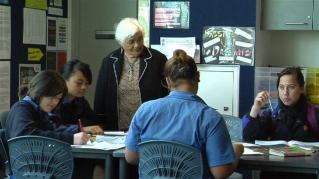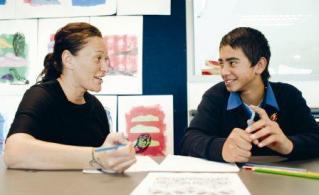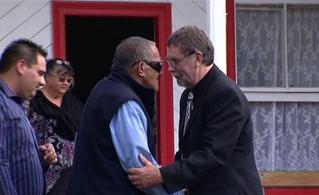Section navigation
Three schools in the Te Kauhua initiative – Hillmorton, Lincoln, and Hornby High Schools - opted to cluster together for purposes of their research inquiry. They worked from a common research question, but tailored their inquiries to their individual school contexts. The cluster schools met regularly over the duration of the project, sharing findings and challenging one another’s practice and thinking. The following case study, prepared for the Ministry of Education by Dr Ruth Gorinski as part of the Te Kauhua case studies report (2010), highlights the approaches and findings of Hornby High School.
Background
Hornby High School (HHS) is a decile three, urban Christchurch school with a roll of 470 students of which 24% identify as Māori. The school has been involved in the Te Kauhua initiative since 2007.
Research Question
How, as part of a cluster arrangement, can a school foster the development of an effective professional learning community that is focused on teaching as inquiry and premised on three underpinning principles: ako (reciprocal learning), culture counts, and productive partnerships?
Impetus for the initiative
Historical data at HHS evidenced that year 9-10 Māori rangatahi (students) leave the school in greater numbers than their non-Māori counterparts. These data provided the impetus for this research, which sought to identify meaningful ways to engage with whānau and to foster Māori student success in learning so that they stay at school.
What was done?
HHS used a number of mechanisms to grow whānau-school partnerships. One - the facilitated conversation model adopted by the three cluster schools to drive progress and change - was utilised as a tool for developing relationships between classroom teachers, students, and their whānau. Heads of departments at HHS introduced hui to discuss departmental and classroom initiatives that could strengthen Māori student achievement outcomes. One of the initiatives implemented – the First Four Weeks for Year 9 Students –had two primary foci:
- to grow whakawhānaungatanga – productive relationships with students
- to create a link between students and curriculum content through the utilisation of the local area/resources in learning and teaching activities.
A second initiative was the introduction of Rangitahi Awards evenings, held to celebrate the success and efforts of Māori students. Staff and Whānau Advisory Group members worked together to create and organise the Rangitahi Awards. This collaborative approach ensured the community was aware of the event and large numbers of whānau and rūnanga representatives attended the celebration. Career Services and a range of tertiary providers attended the Awards evening and were available to talk with rangitahi and whānau. This was a very practical example of the school working with, and recognising Māori students as part of, a whānau.
Another initiative that HHS introduced in partnership with the Whānau Advisory Group, was a tuakana-teina programme with a local primary school. Students from HHS taught basic reo, waiata-a-ringa, and tikanga to students from the primary school. The initiative was implemented at the primary school’s request and provided Hornby High students an opportunity to pass on their knowledge and expertise, thereby building cultural awareness within the school community. Whānau and rūnanga involvement was integral to the research phase and establishment of this programme.
What was the impact on student learning and achievement?
The key result from the research was the increased use of data to inform the school and whānau about the reality of students’ experiences at HHS, particularly Māori rangatahi. Achievement rates in the school have traditionally been analysed in terms of ethnicity and gender. Ethnicity and gender data are now being analysed for a multiplicity of purposes including: student retention, subject choice, unit standard participation, achieved, merit and excellence endorsement, co-curricular participation, library borrowing statistics, Gateway and STAR participation and success, stand down and suspension, and referral from the classroom. This increased use of student data has enabled the school to work in evidence based ways with whānau and rūnanga to support Māori student retention and success.
Key learning
- In working with whānau, assume nothing, but be explicit about everything. Identify an issue and take this to a hui, but then ask how whanau see the issue. Is it in fact an issue? Are there other issues that are the real issues for them?
- Create a climate in which whānau values are honoured and their ideas and suggestions welcomed.
- Ensure the hui is not ‘swamped’ with school-generated ideas.
- Ensure all participants/contributing people know and understand why a programme/activity is being undertaken.
- Small steps should be taken, with all key players being informed throughout the process to optimise success.
- Correct tikanga is vital for every step, be that be for hui or sending panui to the community.
- Follow through on actions/comments when they have been discussed openly. This will grow trust which is critical to the development of productive partnerships.
- Ensure students are invited to give their input and perspective on new programmes and initiatives. This will help them to understand what their role is in a programme.
- Use data as a guide to the next steps for development.
- Full staff professional development in teaching and learning strategies that support Māori student achievement is necessary, in conjunction with Head of Department involvement to ‘filter’ specific department goals.
- The identification of both long-term and short-term goals gives the school and leadership team a common focus/challenge that can serve as a guide throughout the process.
- For a hui to be successful, an agenda needs to be set and follow-up on actions needs to occur.
- It is important to involve whānau from the outset in any initiative. Seeking their opinions, advice, and ideas is key to their involvement.
- A well-organised and passionate leader is a pre-requisite to productive partnerships between whānau and school.
Challenges and opportunities
- Building a ‘base’ of whānau so that traction can be gained in establishing and growing productive partnerships.
- Developing a sense of urgency amongst staff.
Reflective questions
- What are the learning behaviours – key competencies – that our community and school both value?
- How do whānau wish to be informed of their child’s progress in terms of these key competencies?
- How might our school benefit from a Rangitahi Achievement celebration? Is there another way we could celebrate Māori student achievement?
Filed under: Productive partnerships | Effective leaders





